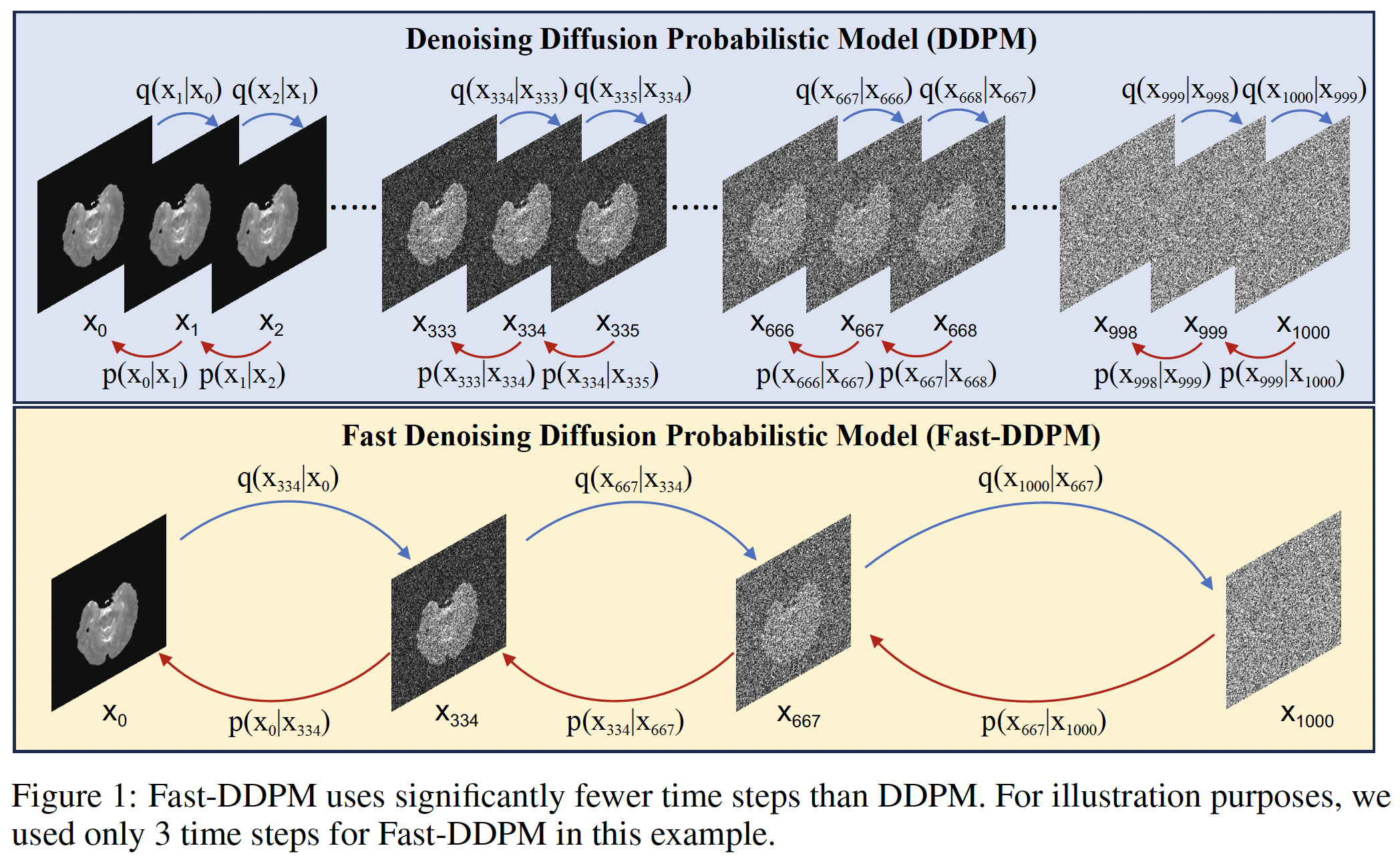Official PyTorch implementation of:
Fast-DDPM: Fast Denoising Diffusion Probabilistic Models for Medical Image-to-Image Generation
We propose Fast-DDPM, a simple yet effective approach that improves training speed, sampling speed, and generation quality of diffusion models simultaneously. Fast-DDPM trains and samples using only 10 time steps, reducing the training time to 0.2x and the sampling time to 0.01x compared to DDPM.
The code is only for research purposes. If you have any questions regarding how to use this code, feel free to contact Hongxu Jiang ([email protected]).
- Python==3.10.6
- torch==1.12.1
- torchvision==0.15.2
- numpy
- opencv-python
- tqdm
- tensorboard
- tensorboardX
- scikit-image
- medpy
- pillow
- scipy
pip install -r requirements.txt
- Prostate-MRI-US-Biopsy dataset
- LDCT-and-Projection-data dataset
- BraTS 2018 dataset
- The processed dataset can be accessed here: https://drive.google.com/file/d/1kF0g8fMR5XPQ2FTbutfTQ-hwG_mTqerx/view?usp=drive_link.
- We provide pretrained model weights for all three tasks, where you can access them here: https://drive.google.com/file/d/1ndS-eLegqwCOUoLT1B-HQiqRQqZUMKVF/view?usp=sharing.
- As shown in ablation study, the defaulted 10 time steps may not be optimal for every task, you're more welcome to train Fast-DDPM model on your dataset using different settings.
- Please download our processed dataset or download from the official websites.
- After downloading, extract the file and put it into folder "data/". The directory structure should be as follows:
├── configs
│
├── data
│ ├── LD_FD_CT_train
│ ├── LD_FD_CT_test
│ ├── PMUB-train
│ ├── PMUB-test
│ ├── Brats_train
│ └── Brats_test
│
├── datasets
│
├── functions
│
├── models
│
└── runners
- Please make sure that the hyperparameters such as scheduler type and timesteps are consistent between training and sampling.
- The total number of time steps is defaulted as 1000 in the paper, so the number of involved time steps for Fast-DDPM should be less than 1000 as an integer.
python fast_ddpm_main.py --config {DATASET}.yml --dataset {DATASET_NAME} --exp {PROJECT_PATH} --doc {MODEL_NAME} --scheduler_type {SAMPLING STRATEGY} --timesteps {STEPS}
python fast_ddpm_main.py --config {DATASET}.yml --dataset {DATASET_NAME} --exp {PROJECT_PATH} --doc {MODEL_NAME} --sample --fid --scheduler_type {SAMPLING STRATEGY} --timesteps {STEPS}
where
DATASET_NAMEshould be selected amongLDFDCTfor image denoising task,BRATSfor image-to-image translation task andPMUBfor multi image super-resolution task.SAMPLING STRATEGYcontrols the scheduler sampling strategy proposed in the paper (either uniform or non-uniform).STEPScontrols how many timesteps used in the training and inference process. It should be an integer less than 1000 for Fast-DDPM, which is 10 by default.
- Please make sure that the hyperparameters such as scheduler type and timesteps are consistent between training and sampling.
- The total number of time steps is defaulted as 1000 in the paper, so the number of time steps for DDPM is defaulted as 1000.
python ddpm_main.py --config {DATASET}.yml --dataset {DATASET_NAME} --exp {PROJECT_PATH} --doc {MODEL_NAME} --timesteps {STEPS}
python ddpm_main.py --config {DATASET}.yml --dataset {DATASET_NAME} --exp {PROJECT_PATH} --doc {MODEL_NAME} --sample --fid --timesteps {STEPS}
where
DATASET_NAMEshould be selected amongLDFDCTfor image denoising task,BRATSfor image-to-image translation task andPMUBfor multi image super-resolution task.STEPScontrols how many timesteps used in the training and inference process. It should be 1000 in the setting of this paper.
- The code is mainly adapted from DDIM.
If you use our code or dataset, please cite our paper as below:
@article{jiang2024fast,
title={Fast-DDPM: Fast Denoising Diffusion Probabilistic Models for Medical Image-to-Image Generation},
author={Jiang, Hongxu and Imran, Muhammad and Ma, Linhai and Zhang, Teng and Zhou, Yuyin and Liang, Muxuan and Gong, Kuang and Shao, Wei},
journal={arXiv preprint arXiv:2405.14802},
year={2024}
}